Is stainless steel cookware safe? Stainless steel cookware is, generally, a non-toxic, safe, and relatively eco-friendly choice. However, those with chromium or nickel sensitivities should be careful. It is important to consider the type of stainless steel carefully and to look out for additions to this type of cookware that might pose a problem.
This post contains affiliate links.
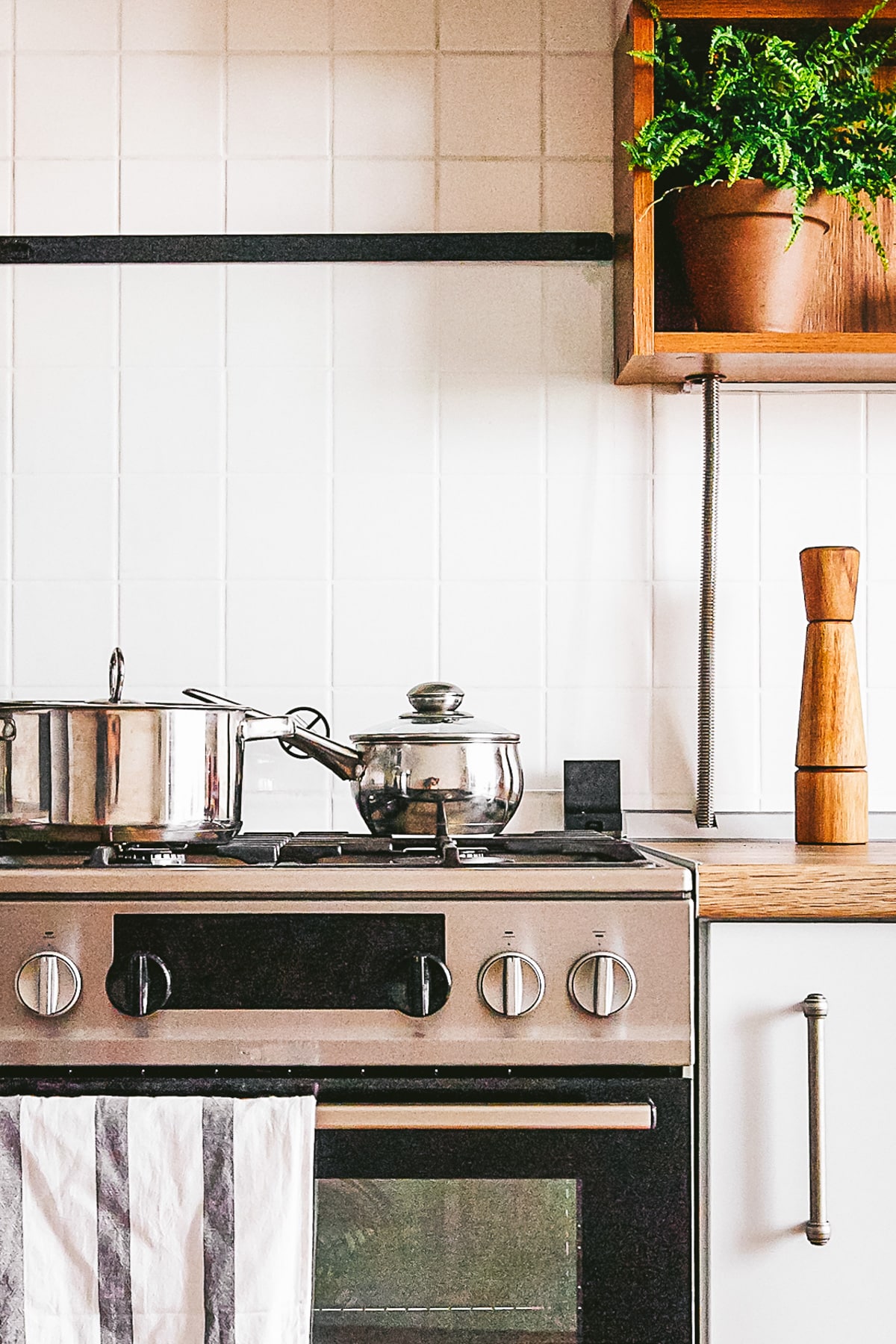
What is stainless steel cookware?
Stainless steel is an alloy of iron and carbon and others metals like chromium that add a passive film of protection over the surface of the material. It can also contain other metals added to deliver desired properties.
To be considered ‘stainless,’ the steel alloy must contain at least 10% chromium by weight. It is chromium that gives this material its non-corroding characteristics and lengthens the lifespan of the metal.
Stainless steel pots and pans are popular options for home cooks and professional chefs worldwide due to the materials’ cleanability, strength, and resistance to corrosion. But with stainless steel cookware, it is important to understand that quality is everything.
Not all pots and pans made from this material will have the same properties, and some are safer, more environmentally friendly, and more sustainable than others.
In order to determine whether or not stainless steel cookware poses any risk to our health, the first thing that we need to look at is the type of stainless steel used in terms of the composition of the material and the characteristics of the alloy.
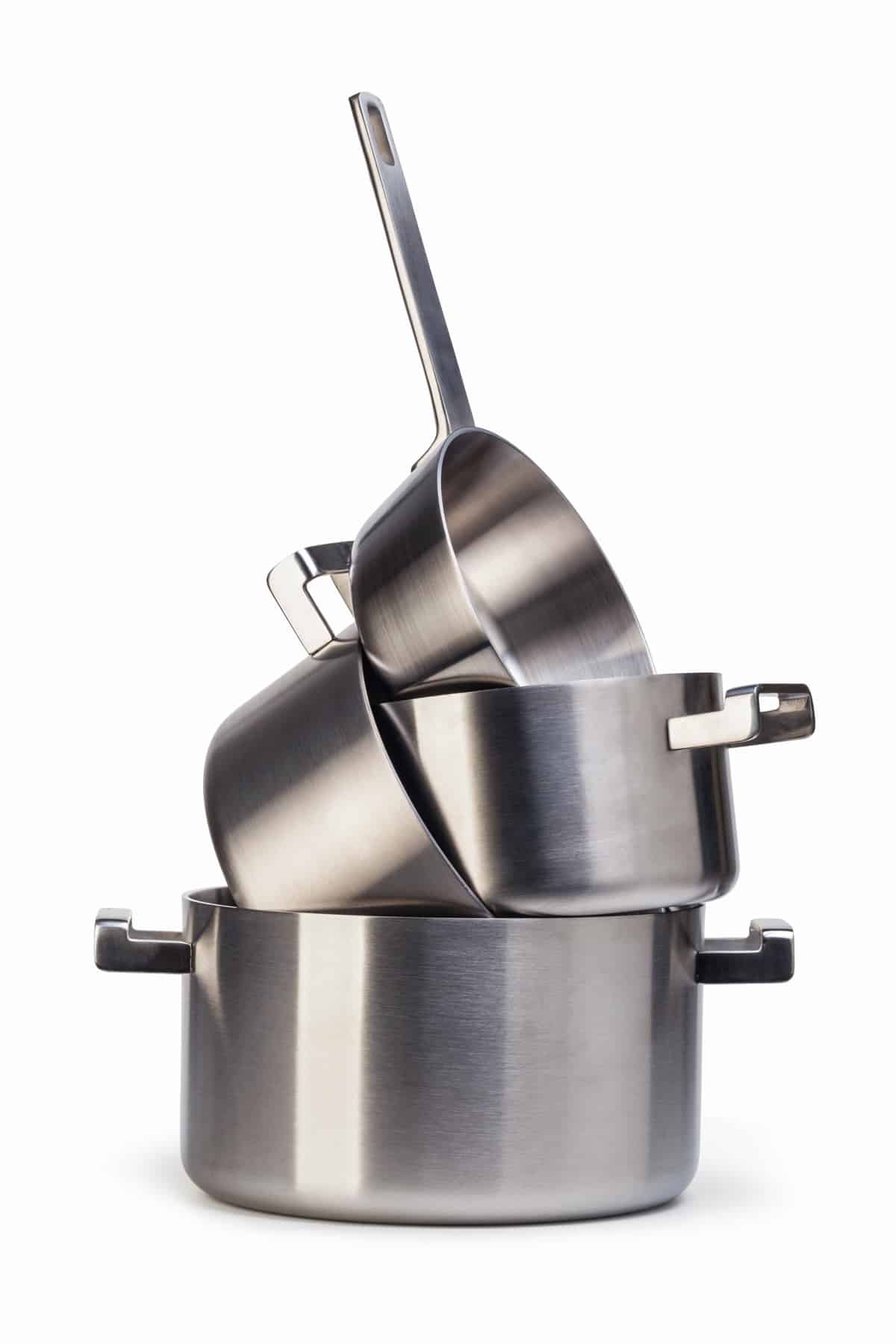
Types Of Stainless Steel Cookware
Since stainless steel is an alloy, looking at the composition of that alloy is important if you are interested in delving deeper into this topic.
There are different types or grades of stainless steel characterized by the structure of the material and the exact make-up of the alloy.
When researching and purchasing stainless steel pans or other stainless steel cookware, you will often see a number that tells you the grade you are looking at. Looking at the number can help you to determine the precise composition of the material.
When it comes to cookware, the most commonly used grade of stainless steel is austenitic stainless steel in the 300 series – type 304.
Austenitic stainless steel is one of five classes of this material. It is characterized by a crystalline structure. This structure is achieved by adding stabilizing elements such as nickel, or manganese, and nitrogen to the mix.
Austenitic stainless steels in the 300 series have typically achieved their structure by adding nickel.
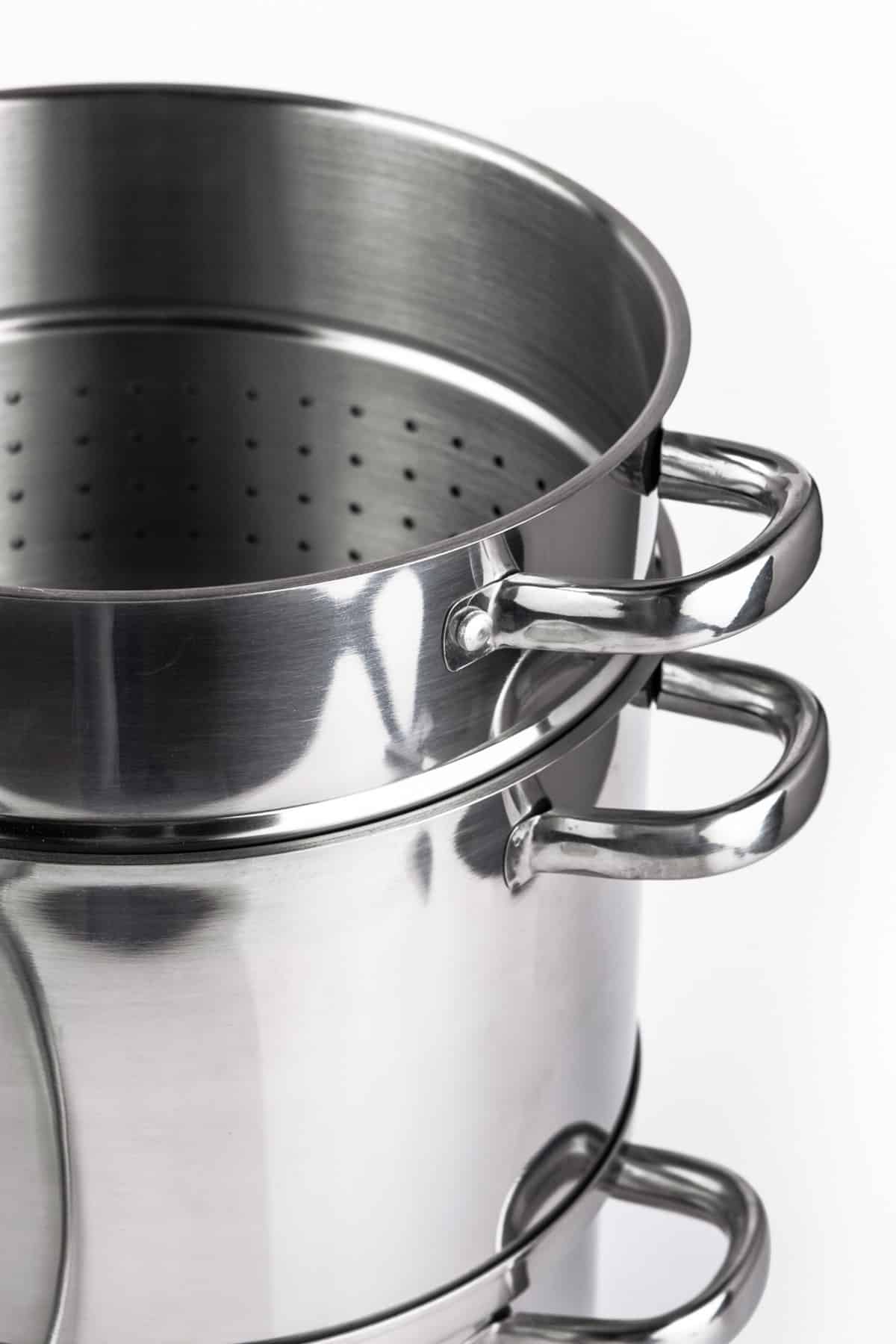
304 Stainless Steel
304 stainless steel is, as mentioned above, the most common grade used for stainless steel pots and pans, as well as for cutlery and other kitchen equipment.
This grade of stainless steel is also commonly called 18/10 or 18/8 stainless steel. These numbers refer to the chromium and nickel content in the alloy. So cookware with this grade of stainless steel contains 18% chromium and either 10% or 8% nickel.
The nickel content makes the stainless steel more corrosion-resistant. However, adding nickel does make the material more costly, so stainless steel cookware sets made using this grade of stainless steel tend to be the most expensive.
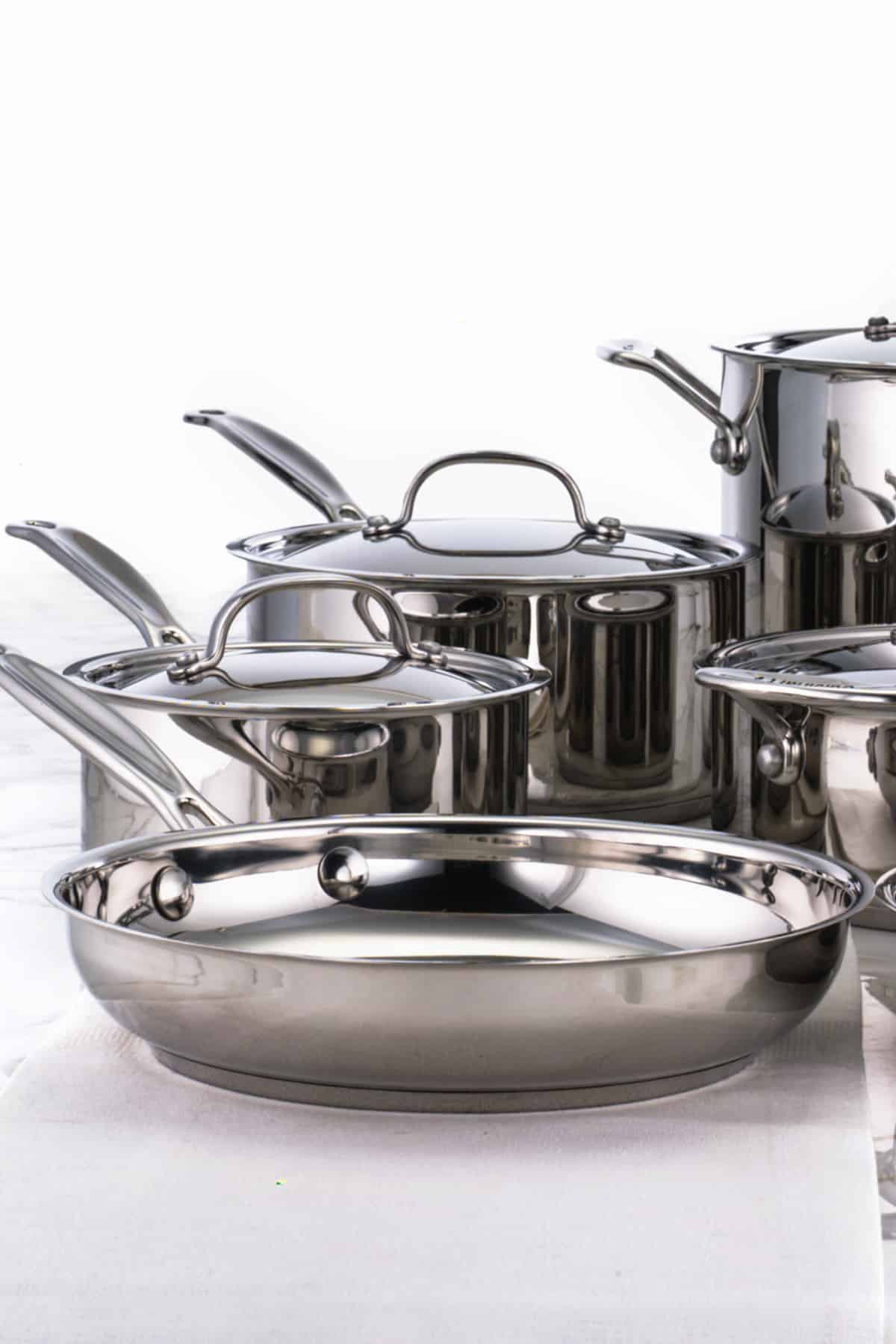
430 Stainless Steel
Another grade of stainless steel commonly used for cookware is 430. This is also known as 18/0. So while it also contains chromium, it is free from nickel.
This is in the ferritic class of stainless steel and is, therefore, magnetic, unlike the above, which is not considered magnetic. Though it can be magnetized through electricity for periods of time.
The absence of nickel in cookware of this type means that it is somewhat less corrosion-resistant, and it will be less durable than the above. But this is an inexpensive grade, and so is often used in cheaper stainless steel kitchen items.
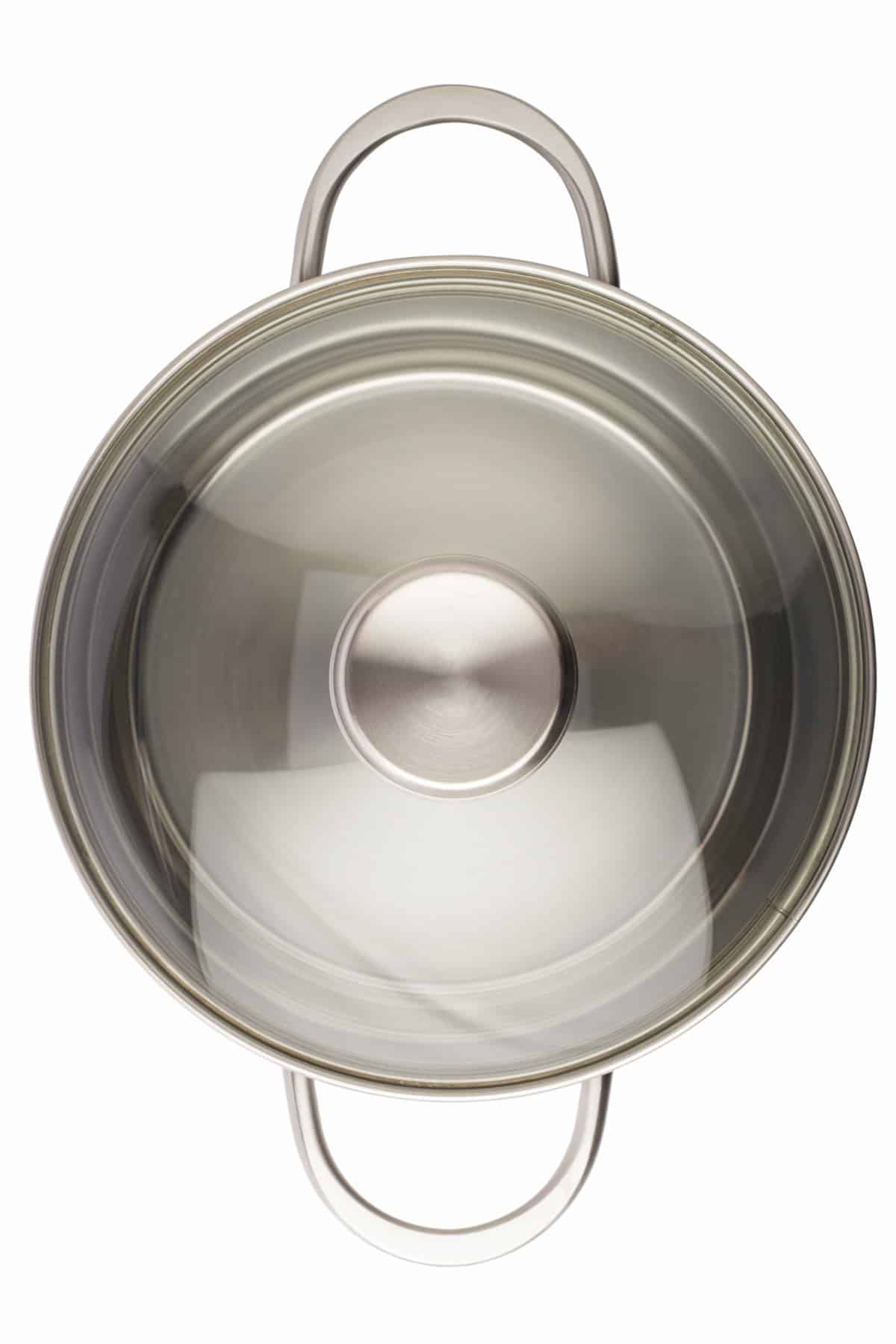
Titanium-Infused or Nano-Infused Stainless Steel
Some companies now offer stainless steel cookware that is infused with titanium. Titanium-Infused cookware will use an alloy that also contains titanium to increase the strength of the material and to provide a more ‘non-stick’ surface. These are typically made from 439 stainless steel or 316Ti stainless steel.
Unfortunately, it can be difficult to obtain information about whether nano-particles are used in titanium-infused products. And as we will discuss below, this may have an impact on the safety or toxicity of the material. With a lack of transparency in the industry, we don’t think titanium-infused cookware is the best choice.
The alloy of stainless steel is just one thing to look at when delving into the safety and sustainability profile of stainless steel cookware. Pots and pans made from stainless steel are not typically comprised of stainless steel alone.
This type of cookware is typically made of bonded layers, with a core material (typically either aluminum or copper) sandwiched between the stainless steel cooking surface and exterior coating.
The reason for this is that stainless steel is durable but does not conduct heat very well. Aluminum and copper both transfer and distribute heat extremely well. So combining metals means you get both durability and good heat conduction.
These core materials are held within the structure of the cookware and, unless the object is seriously damaged, would never come into contact with food. However, the precise details of the construction of the cookware can have a bearing on its durability and safety profile.
When choosing stainless steel cookware, you will often come across the term ‘ply.’ This refers to how many layers there are bonded between the food you are cooking and the disc of another metal within the base of the pot or pan.
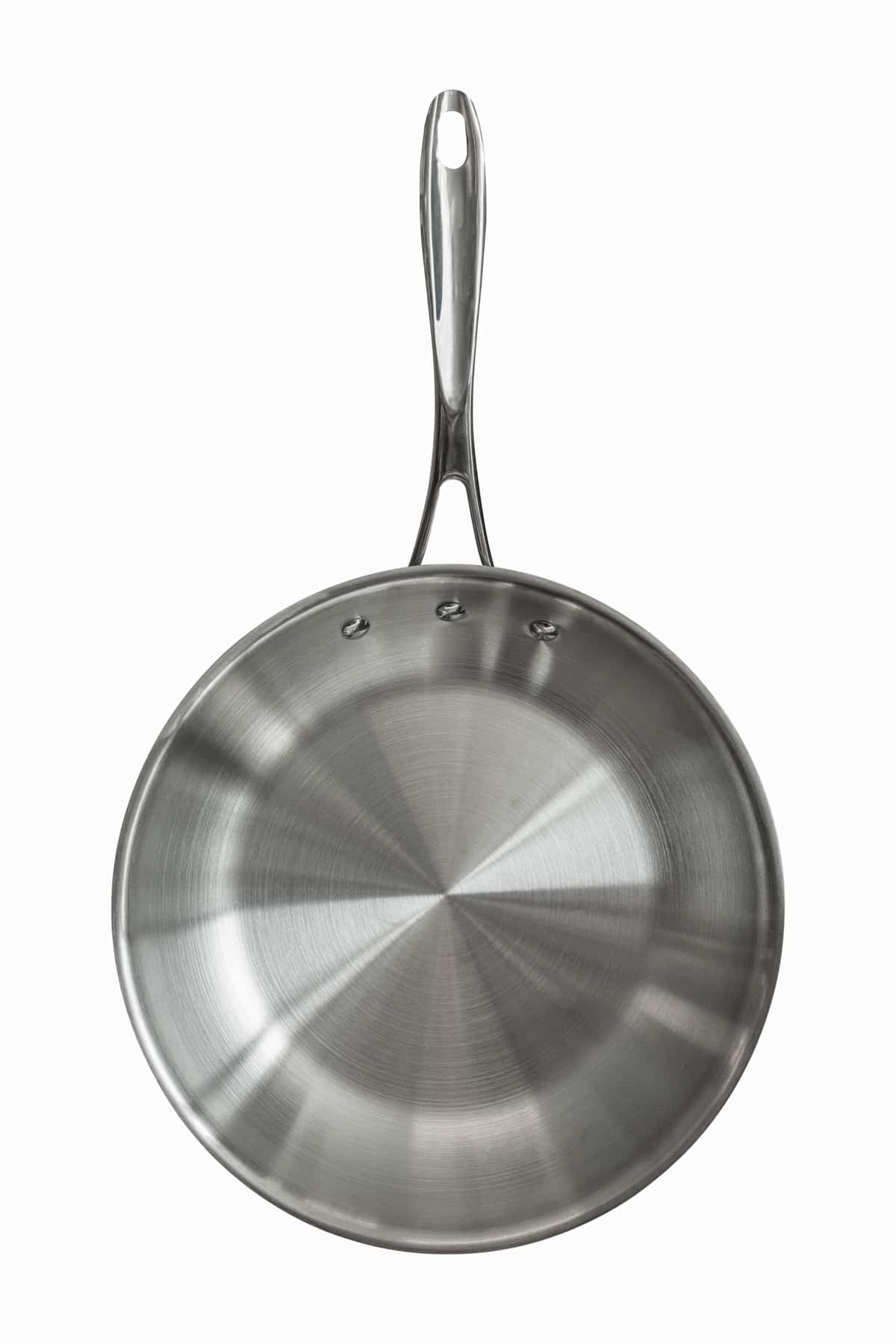
Tri-Ply
Tri-ply refers to a basic three-layer composition, with an aluminum core or sometimes copper sandwiched between the stainless steel layers. Some brands offer cookware with aluminum sandwiched in the sides of pots and pans, as well as in the base.
5-Ply
A 5-ply option has, as the name implies, 5 layers of metal. Though the addition of extra layers makes cookware heavier and typically more expensive. Thickness is said to increase the durability of the products and make them less likely to warp or be damaged over time.
7-Ply
Today, when searching for stainless steel cookware, you might also see 7-ply products advertised. These include stainless steel and aluminum layers, including a magnetic layer that makes them suited to use on an induction cooktop.
Note, however, that most brands offering this option are using ‘titanium-infused’ stainless steel, so as mentioned above, we advise caution and do not recommend choosing these since it is typically unclear if they use nano-titanium particles. And this has implications for the product’s safety.
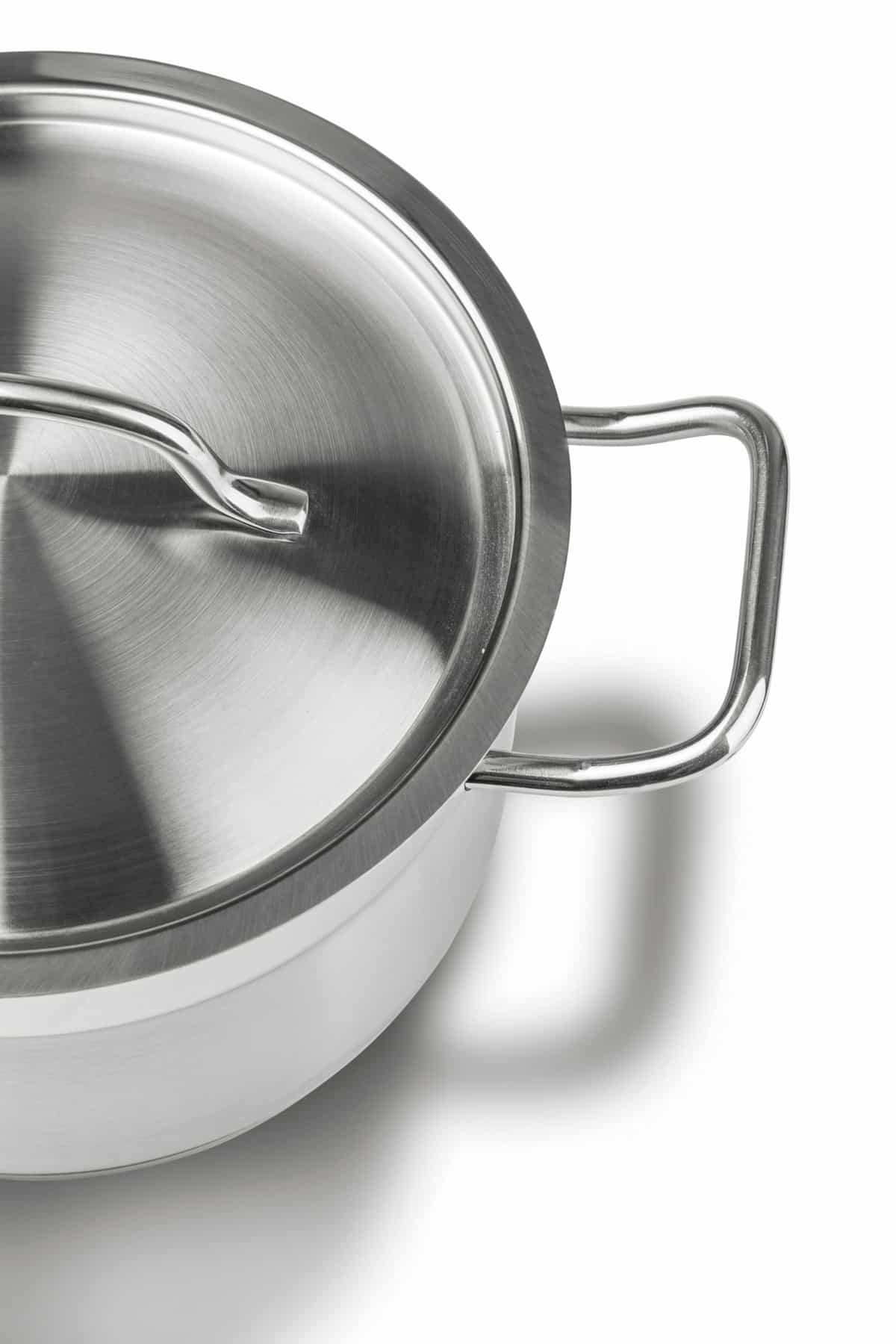
Non-Stick Coatings on Stainless Steel Pans
Another thing to note when comparing different kinds of stainless steel cookware is that some options are coated with a nonstick coating made from a kind of plastic called PTFE (polytetrafluoroethylene).
Teflon (TM) is a well-known brand name associated with this material. So if you hear about Teflon cookware, this is the same thing. This material is used to prevent food from sticking to the cooking surface and to make cleaning the non-stick pans easier. Non-stick cookware is, of course, a popular choice.
PTFE used to be a material of concern because it contained potentially toxic PFOA (perfluorooctanoic acid). This was eliminated by all major cookware brands by 2013. However, concerns remain, and there are other reasons why we think that there are better options when it comes to cookware.

What kind of stainless steel is non-toxic?
Now that we have looked at the different types of stainless steel cookware and examined some of the properties of the materials they contain, we can begin to look more closely at materials and composition to determine the potential toxicity within these products.
First of all, let’s look at whether the stainless steel cooking surface of stainless steel cookware is non-toxic.
The good news is that stainless steel is considered to be food safe and non-toxic as long as the alloy used contains at least 16% chromium.
This chromium content ensures that the cooking surface is hard and non-reactive, so pathogens are not harbored there, and heavy metals won’t mix too greatly with the food.
However, it is important to understand that when you use stainless steel cookware, small quantities of chromium and nickel are released into food.
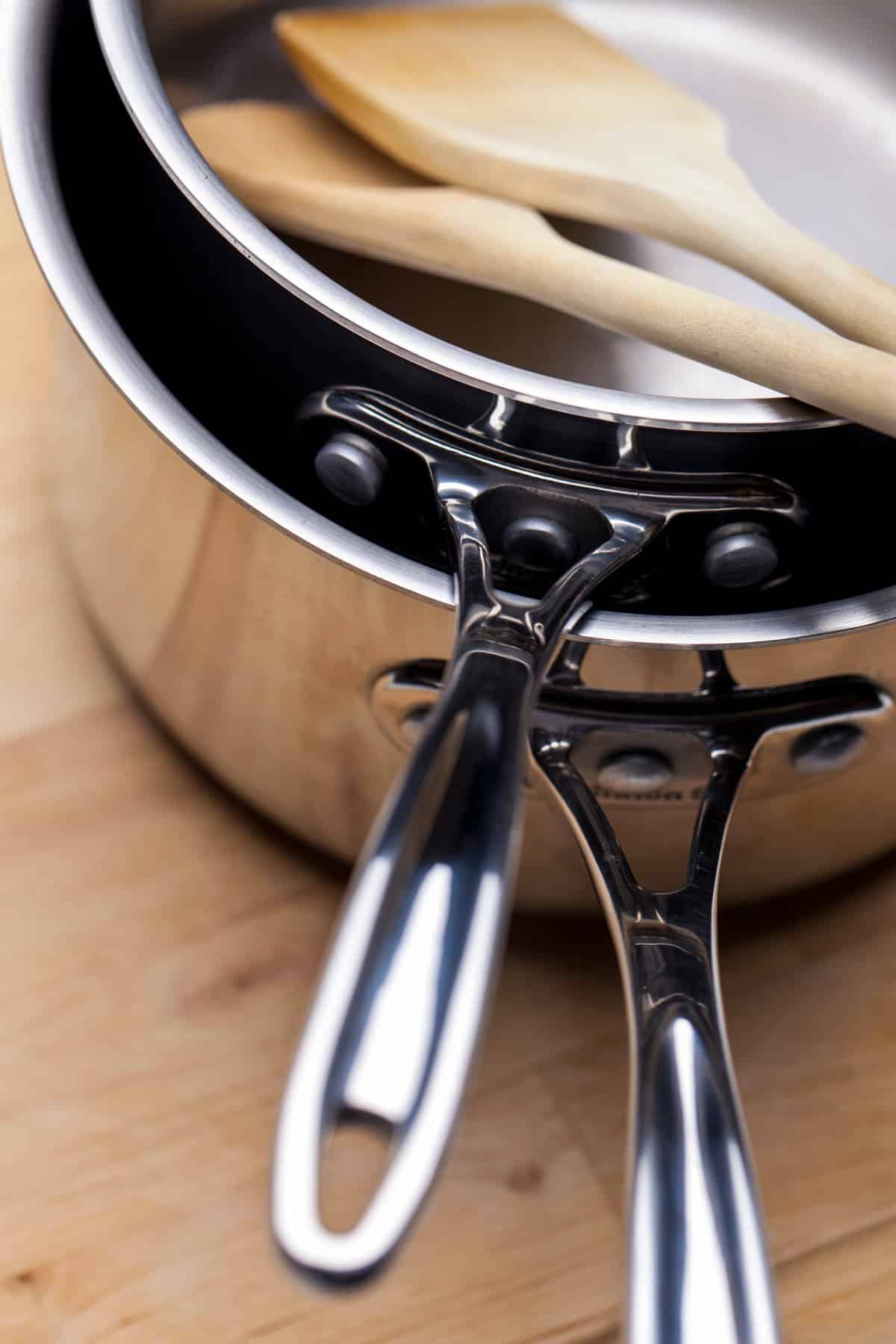
Are chromium and nickel problematic?
Scientists have established that the amounts of chromium and nickel that leaches into food from stainless steel cookware depends on a range of factors, including the specific type of steel, the acidity of the food being cooked, the cooking time, and the number of times a pot or pan has been used.
Fortunately, for most people, the tiny quantities of chromium and nickel that are released into foods from stainless steel are unlikely to cause any harm.
Both chromium and nickel are essential nutrients. Nickel is only required by our bodies in very small amounts, and too much chromium is not ideal for our health. But the quantities of these materials released by stainless steels that contain them pose no risk to most people.
However, some individuals have allergies or sensitivities to chromium, and nickel may have health concerns.
Leaching from stainless steel cookware most typically remains below the levels that trigger allergies. However, those with a more pronounced allergy to chromium should avoid cooking in stainless steel. And those with a nickel allergy should stick to a zero nickel alloy to avoid any potential health issues.
So, we have established that stainless steel itself is non-toxic and poses no health risks to most people. Only those known to be highly sensitive to chromium or nickel should avoid its use.
However, as we have mentioned above, stainless steel pans don’t just contain stainless steel. They also contain other materials. And it is with these other materials that toxicity issues can potentially creep in.
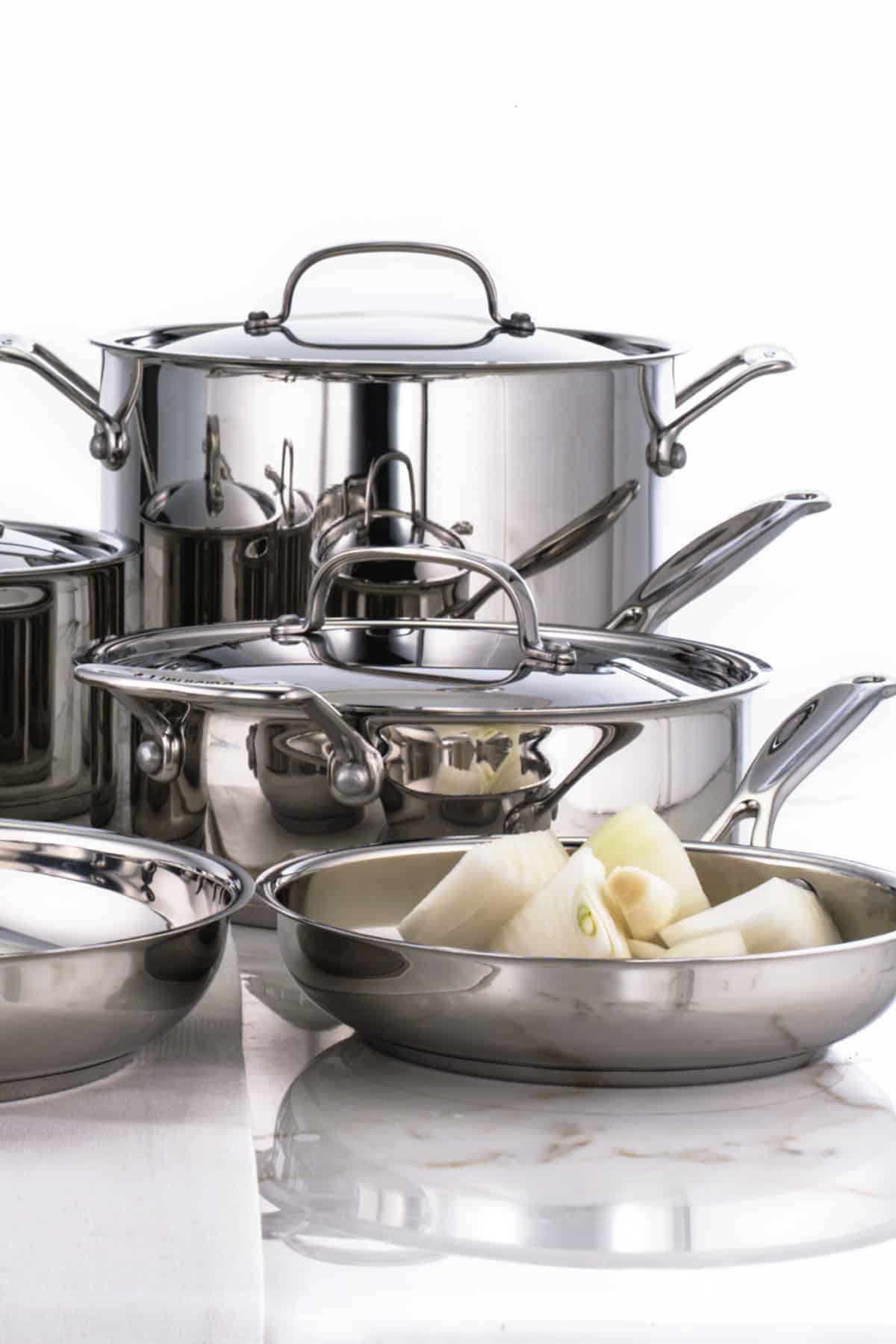
Why is nano-titanium problematic?
Above, we mentioned that some stainless steel cookware is ‘titanium-infused’ and sometimes uses titanium nano-particles. But there is little transparency within the industry, so it can often be difficult to ascertain whether nano-titanium particles are present in the cookware or not.
Nano-materials can also be an issue in ceramic cookware since most ceramic cookware brands are coated with these too.
The presence of nano-particles rings alarm bells because recent research suggests that nanotechnologies might bring with them potential toxicity risks. The problem is we don’t yet know the impacts. Especially of long-term exposure to the human body, and so many, many questions remain unanswered.
Due to their tiny size, nanoparticles have different chemical and structural properties to larger particles, and there is evidence to suggest that these titanium nanoparticles may pose a risk to human health.
So while evidence remains patchy and we need to learn more, we cannot confidently say that any stainless steel pan containing nano-particles is non-toxic.
Why is aluminum problematic?
Remember, most stainless steel cookware will contain aluminum (or copper) sandwiched between the cooking surface and the exterior surface of the pots and pans.
Where a pan is of sufficiently high quality and the core is not breached, aluminum in a stainless steel pan will remain fully contained and won’t come into contact with your food. This can, therefore, be perfectly safe cookware.
Small amounts of aluminum do not typically pose a health risk. However, it is always safer to replace any damaged cookware promptly to eliminate any risk of these metals leaching into your food. Make sure you do not use dented, pitted, or otherwise damaged pans or those with aluminum cooking surfaces.
Prolonged ingestion of aluminum in food can potentially cause various health problems. Aluminum cookware, or aluminum exposed from inside stainless steel cookware, could potentially add to this problem.
You should also note that things like cooking at high heat or cooking more acidic foods, such as tomatoes or tomato sauce, can increase the amount of metals that can potentially leach into the food that you eat.
Why is PTFE problematic?
If your stainless steel pan has a nonstick coating, then this can also raise certain toxicity concerns.
Scientists revealed, as mentioned above, that PFOA used formerly in the manufacture of PTFE products, such as nonstick pots and nonstick frying pans, can be carcinogenic to people. However, PFOA has not been used for nonstick cookware since 2013, and it is no longer made in the United States.
Unfortunately, however, in many cases, this has just been switched for another similar chemical called Gen X. While the industry often maintains that this is safer than PFOA, there is emerging evidence that suggests it may also have detrimental long-term health effects. While inconclusive, there are certainly reasons to doubt its safety.
While the quantities of PFAS in nonstick cookware may only be small, there is limited evidence that they categorically won’t harm your health.
When heated to over 500F, PTFE nonstick cookware can also release toxic fumes.
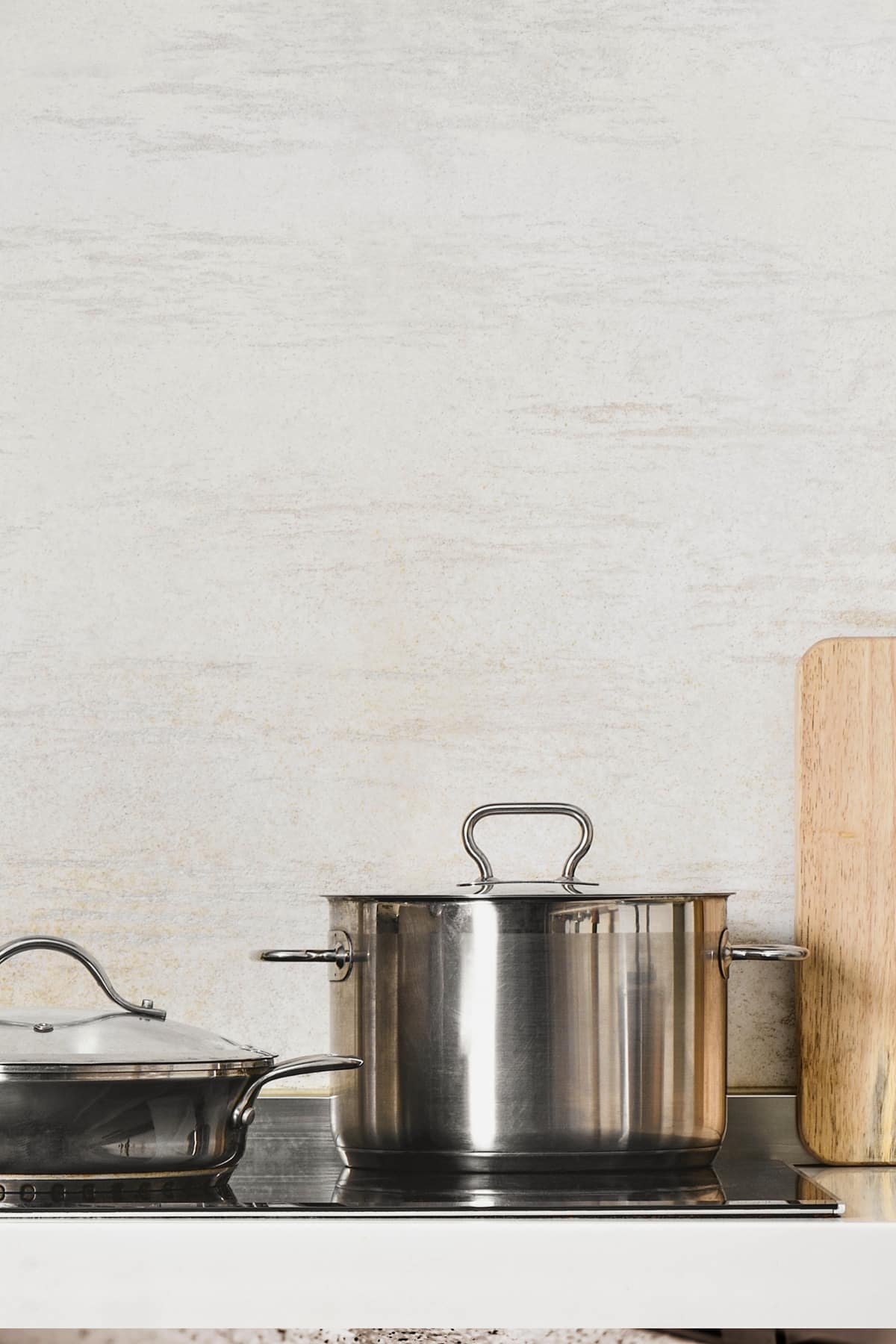
What are the potential health impacts of cooking with stainless steel?
Putting all of the above together, we can begin to see that stainless steel itself will not typically result in any adverse health impacts for those who cook with it.
The only exception to this is for people who are sensitive to, or allergic to, chromium or nickel. Those who are sensitive or allergic can experience skin rashes and contact dermatology when handling and cooking with these pans.
Aluminum inside stainless steel cookware usually won’t cause any health problems because it is contained within the structure and does not come into contact with food. However, in damaged pans, where it becomes exposed and can leach out, it can potentially cause adverse health effects.
Aluminum is around us all the time, and we will inevitably be exposed to it and ingest some every day. But the aluminum that comes from cookware and food is unlikely to be very high, and most passes through our bodies without entering our bloodstream.
Though some people believe that there is, there is, in fact, no hard evidence that suggests a link between exposure through food or cookware and cognitive issues, dementia, or Alzheimer’s disease. This is not typically related to exposure through food but to occupational exposure.
Those with poor kidney function may not be able to clear aluminum from their body as successfully. As a result, it may build up and accumulate, causing confusion, fatigue, muscle weakness, bone problems, or even seizures. Severe symptoms can lead to numerous lung, digestive system, bone, and brain problems and anemia.
Remember, however, that cookware is unlikely to be a major source of aluminum. If you are worried about aluminum, avoid cooking in it (make sure stainless steel pots with aluminum in them are undamaged) but also avoid processed foods with additives, excessive tea drinking, etc… and think about other sources of exposure in your lifestyle and environment.
Additions to stainless steel cookware, such as nano-titanium and the nonstick PTFE coatings that are sometimes applied to stainless steel cookware, can potentially cause serious health issues.
While more research into the human health impacts of nano titanium particles on human health is required to draw firm conclusions, there is some evidence that suggests that these nanoparticles may play a role in oxidative stress, inflammation, genotoxicity, metabolic change, and potential carcinogenesis.
PFOA and other PFAS (potentially but inconclusively including the Gen X used to replace it) have been linked to a great many health impacts, including cancers, decreased response to vaccines, inflammation, hypertension, and preeclampsia.
The toxic fumes released by PTFE coating when heated to over 500F (260C) also pose a risk to humans (creating flu-like symptoms known as polymer fume fever) and have even been known to kill small pets.
So while the stainless steel in stainless steel cookware might be non-toxic and perfectly fine for most people, other materials within stainless steel cookware – especially titanium nanoparticles and nonstick PTFE coatings are best avoided to prevent potential health impacts.
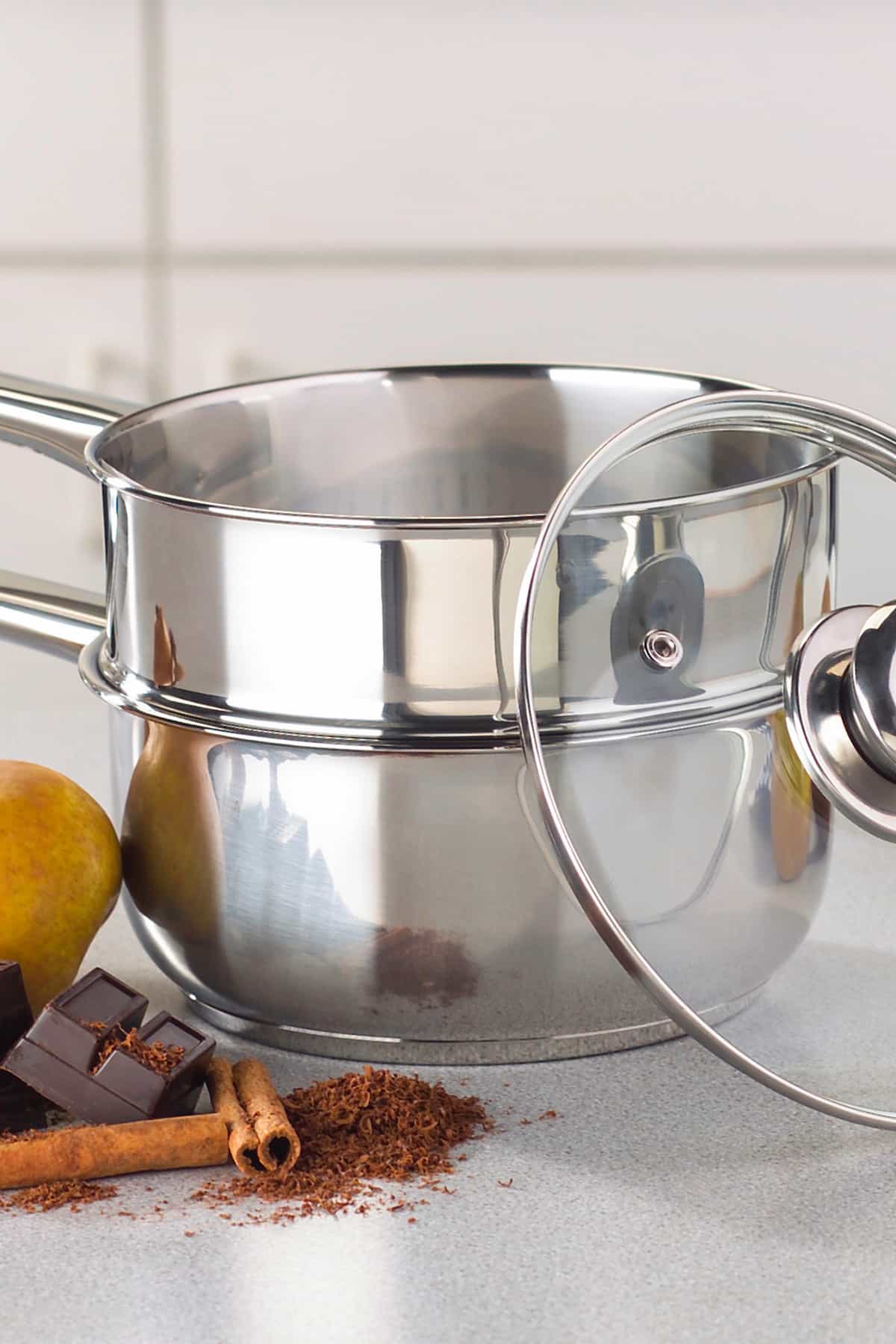
Does stainless steel have environmental impacts?
As well as considering the potential impacts of stainless steel cookware on human health, sustainable consumers should also be sure to consider the environmental impact of every choice that they make.
In order to look at the environmental impacts and sustainability credentials of stainless steel cookware, we need to look at:
- The materials it contains, and where these materials come from.
- The carbon and environmental costs of extracting or producing those materials.
- The carbon and environmental cost of manufacturing.
- How long do the products last?
- And what happens to them at the end of their useful life.
The Environmental Impact of Mining Metals
Stainless steel is made, as we have discussed above, using iron, carbon, chromium, and other metals (commonly nickel in the grade most commonly used for stainless steel cookware).
This material can be made in two different ways. It can be produced by mining the base materials and smelting in a (typically coal-fired) blast furnace. Or it can be produced from recycled materials placed into an electric arc furnace.
The former option is by far the most costly in environmental terms. It has the greatest detrimental impact on the environment due to the impacts of the extractive industry (mining iron ore and other ingredients), the carbon emissions associated with this industry, and the burning of fossil fuels.
Fortunately, around 80% of all new stainless steel is now made using scrap metal and electricity. This not only avoids the need to mine new metals but also makes it possible to utilize renewable forms of energy for the process.
The Environmental Impact of Producing Stainless Steel
The processes involved in creating stainless steel are also now far less wasteful than formerly. And what were formerly waste products are often now used in other industries – moving us much closer to closed-loop, circular systems.
Since the 1960s, the energy required and carbon dioxide emitted by steel production have decreased by more than half. Though more work still has to be done, especially on switching entirely away from fossil fuels for electricity production, the environmental impacts of this industry are far lower than they used to be.
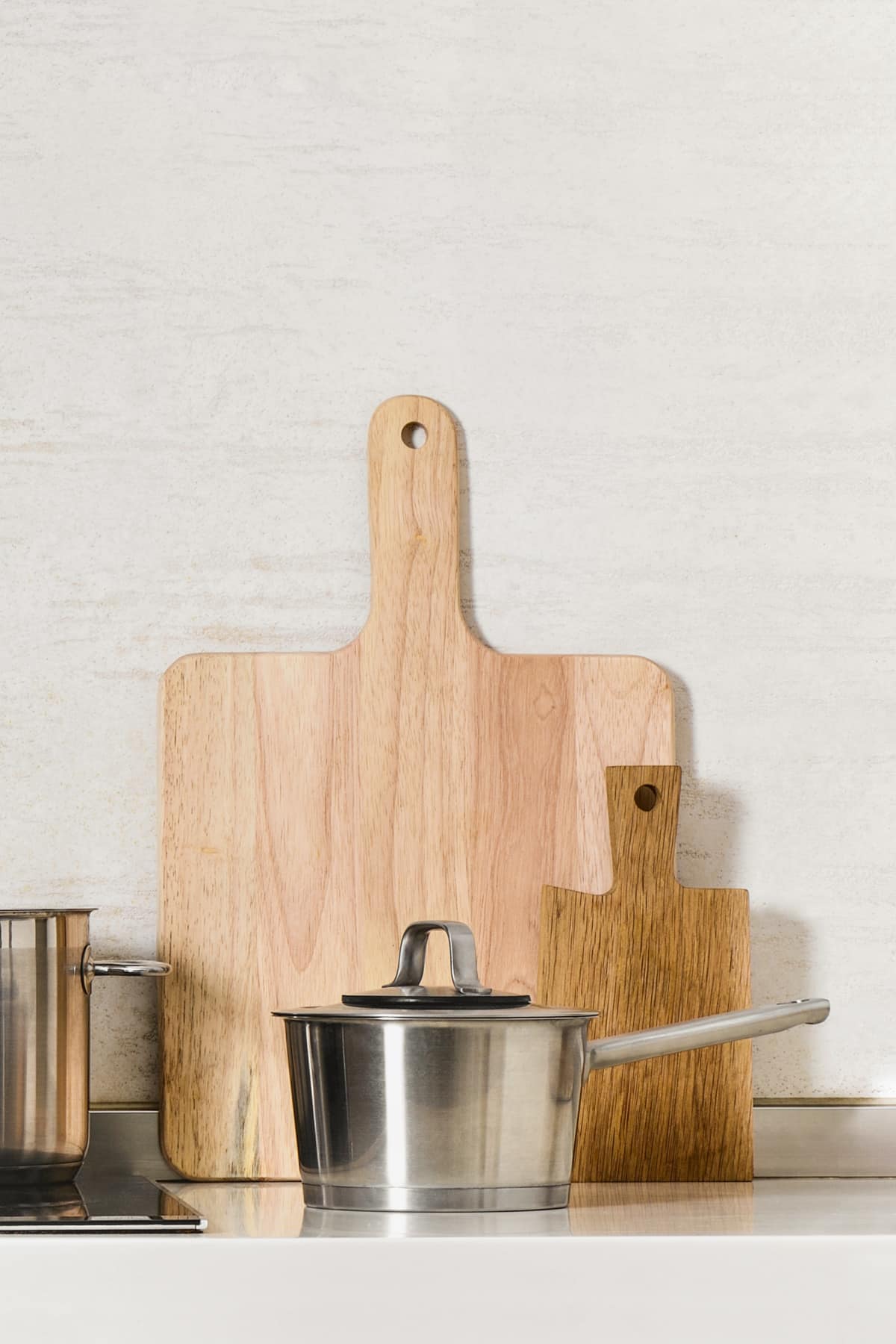
The Lifecycle of Stainless Steel – Sustainability Considerations
When we look at the durability of stainless steel, we can see that this is a material that lasts. High-quality stainless steel cookware can be an investment that will provide you with effective cooking items for years and years.
Choosing well-made and good-quality pots and pans is a sustainable choice since, inevitably, the creation of any new item comes at a cost. The more we can lower our consumption, and the longer we can keep items we own in use and avoid buying new ones, the more eco-friendly and sustainable our lifestyles will be. (Does it have a lifetime warranty? If It does, it will probably be more likely to last a long time.)
Even when stainless steel is no longer useful to us in its current form, it can be recycled and used again – not only once or twice, but infinitely. Stainless steel can be recycled repeatedly without losing quality.
Globally, it is predicted that around 85% of stainless steel is recycled at the end of its life. In some regions, the recovery rate for the material can be close to 100%. This means not only that new material does not need to be mined as much. But also that waste materials are not discarded or sent to landfill.
Is Stainless Steel Cookware Sustainable?
Stainless steel can, as a material, be eco-friendly and sustainable, though it is important to look at the method used for its production.
However, when trying to work out whether or not the cookware you choose is sustainable or has a negative environmental impact, you also need to consider its other materials.
The most sustainable options will not only be created using recycled stainless steel but also recycled aluminum or copper. These mined materials can also be costly to extract from the ground but can also, fortunately, be recycled.
If the cookware has a nonstick coating such as PTFE, there are obviously many more environmental issues to contend with. So these options will not represent the most sustainable choice.
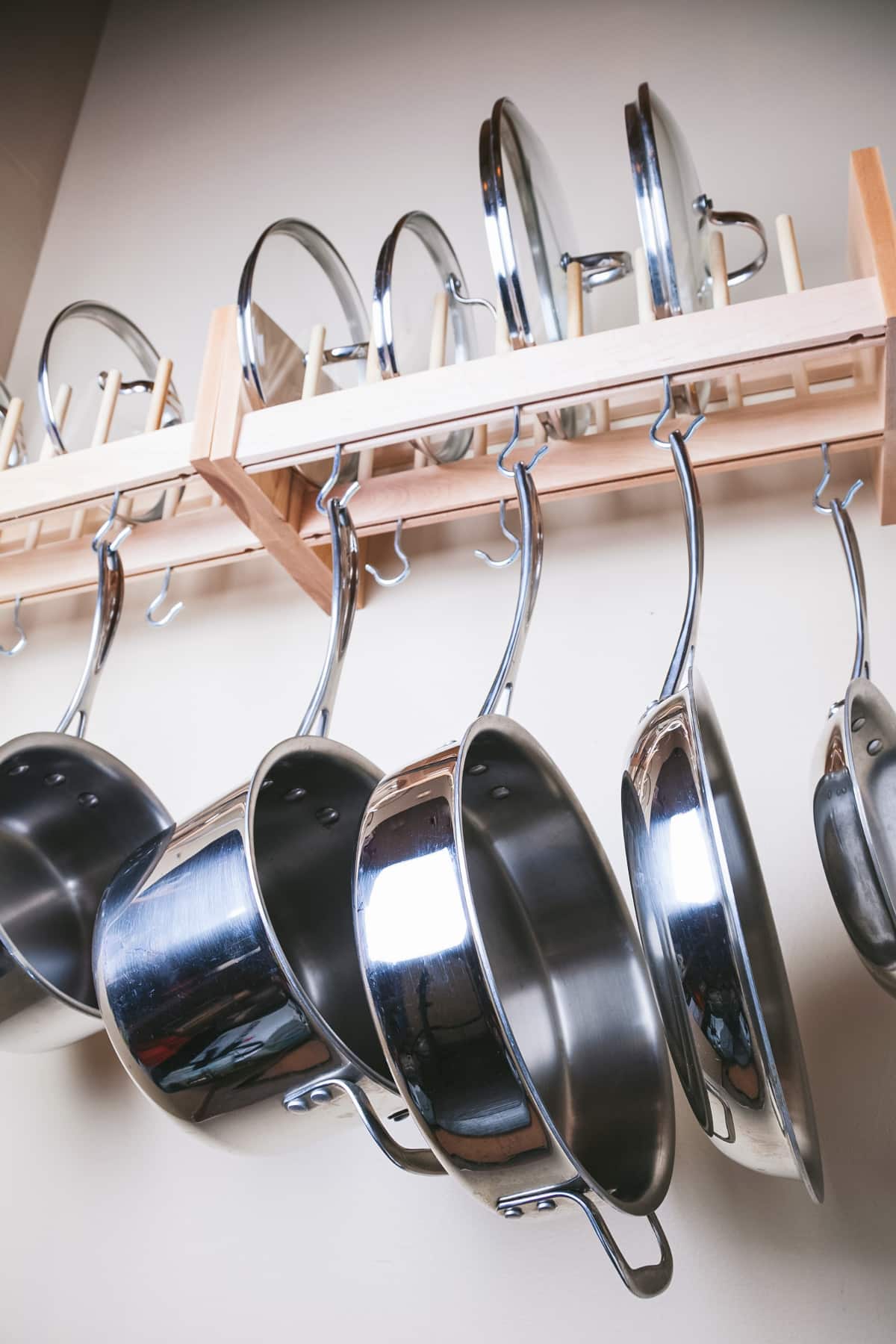
20 Non-Toxic Stainless Steel Cookware Picks
If you are looking for the best non-toxic cookware that is stainless steel, this list is for you.
Best 304 Stainless Steel Cookware (Made With Nickel)
Remember, 304 stainless steel contains nickel. It is also called 18/10 or 18/8 stainless steel.
All-Clad
- All-Clad D5 Brushed Stainless Steel 10-Piece Cookware Set
- All-Clad D5 Brushed Stainless Steel 4-Quart Soup Pot
- All-Clad D5 Brushed Stainless Steel 2 Quart Pot
- All-Clad Copper Core Stainless Steel 10-Piece Cookware
- All-Clad Copper Core Stainless Steel 7-Piece Cookware Set
- All-Clad Copper Core Stainless Steel 3-Quart Saucepan
Deyemere
- Deyemere Industry 10-Pc. Stainless Steel Cookware Set
- Demeyere Industry Stainless Steel 10-inch Pan
- Demeyere Industry Dutch Oven Stainless Steel
- Demeyere Industry 5-ply 3-Quart Stainless Steel Saute Pan
- Demeyere Industry 5-ply 8-Quatt stainless steel stockpot
- Demeyere Industry 5-ply 5 Quart Flat Bottom Wok
- Demeyere Industry 5-ply Stainless Steel Lasagna Pan
Legends
- Legends 5-Ply Copper Core Stainless Steel 14-Piece Cookware Set
- Legends 5-Ply Stainless Steel 14-Piece Cookware Set
Made In
- Made In Stainless Steel 8-Quart Stock Pot
- Made In Stainless Steel 3-Quart Saucier Pan
- Made In Stainless Steel 3.5-Quart Sauté Pan
Viking
- Viking 5-Ply Stainless Steel 10-Piece Cookware Set
- Viking 5-Ply Stainless Steel 7-Piece Cookware Set

How To Care For Stainless Steel Cookware
Treat your pans carefully to keep them safe and to keep them in use for as long as possible. Don’t expose your pots and pans to thermal shock (placing hot pans on cold surfaces, for example). And follow manufacturers’ instructions to see how high temperatures can be before warping, damage, or other issues arise.
- Clean your stainless steel pots and pans after use with natural soap and a non-abrasive cleaning sponge or cloth.
- Boil water with a few spoonfuls of baking soda in the pan to get rid of burnt on food or other stubborn substances.
- Wipe stainless steel pots and pans with vinegar to remove discoloration on the surface.
- After washing, dry your pans carefully before you hang them up or put them away.
FAQ
Stainless steel pans are not non-stick unless they have been coated with PTFE or another non-stick coating. But since non-stick coatings typically all come with health and safety and/or numerous environmental concerns, non-stick is not something we should be looking for in our cookware.
Though food can sometimes get stuck when cooking in stainless steel, the good news is that with a little adjustment to your cooking methods, you should not find this much of a problem.
– Keep cookware scrupulously clean, ensuring you wash and dry it thoroughly after each use.
– Bring cold ingredients up to room temperature before cooking.
– Preheat the pan and use cooking oil, making sure the oil is hot before you add your ingredients.
– Be patient, and don’t try to move or flip foods too quickly.
– Don’t overcrowd the pot or pan you are cooking in.
When looking for healthy cookware, it is best to avoid those non-stick options. No non-stick options are entirely free from health and environmental concerns.
Aluminum pans are also not ideal. Copper, too, though beautiful, does come with some caveats. I love to cook in copper, but remember – it needs a good coating so that the copper does not leach into the food.
Good quality copper cookware with a stainless steel coating or stainless steel pans with copper bases (as long as you have no sensitivity to chromium or nickel).
Enameled cast iron pans, and 100% ceramic pots (as opposed to those with coatings) are typically among the healthiest and most sustainable options and are my top picks.
This might be a controversial topic, but I do not like to use pans with any non-stick coating. In my option, none can be guaranteed as 100% safe.
The only coating I advocate is an enamel coating on cast iron pots and pans like those from Le Creuset, for example. An enamel coating is largely naturally non-stick, making these very easy to use and maintain, and they can be used on an induction cooktop too.
Final Words
Unless you are allergic to chromium or nickel, stainless steel pans can be a relatively safe, convenient, and sustainable choice. But choose good quality options, and avoid potential problems by steering clear of titanium-infused and PTFE-coated products.
This post may contain affiliate links, meaning I’ll receive a commission if you purchase through those links at no extra cost to you. Please read our full disclosure for more information. Thank you for supporting Raepublic.

Wow, so much great info. I loved learning about the environmental impact.
Yay! So glad you found a part that resonated with you.